

Review of the W17 ..... by a noted European racer
INTRODUCTION: In 2020, I was contacted by a Farrier racer in Germany who was interested in upscaling his F82R for race performance. He had already built and mounted new amas of a more modern design as well as adding C-foils for added stability, so was now looking to update his rig. With new sails planned, I ended up designing a new Mark.ll Wingmast for him and the excellent results he had with this in subsequent years led this intrepid skipper to become interested in the new design work I was undertaking, presently represented by the W17. As an engineer with an enquiring mind, he expressed an interest to come out to North America to see and test the W17 for himself, something that I was totally supportive of. His name is Andr é Baetz and as there was another W17R not too far away, I organized that Andr é and I would trail my boat out to Maine on the US East Coast, so that he would have a 2nd boat to sail and therefore not confine his input to just one source. As Andr é is a respected and successful skipper in Europe, I consider his observations worth sharing, so after a week sailing in Maine and another two in Vermont, Andr é returned home with an agreement that I would get a report from him in the coming days or weeks. True to his word, I now have it.
So here it is with some pics added. I have added Andr é 's sailing bio at the end. Mike.
=================================================================================
My Review of the W17 trimaran ,..... (by André Baetz, August 2023)

My very first reaction came when I prepared to lower the rudder. Compared to my long deep transom-hung foil on my F82R, this one looked like a postage stamp! I was told it was small to be able to sail in shallow draft but also, that because it was installed UNDER the bottom as a spade rudder, it was more efficient. This way the bottom of the main hull works as an endplate, something which is not possible on my F82R where I partly fly the main hull. The rudder blade of the W17 also has an upper fence to cut risk of ventilation when heeled, but I was still skeptical, and rather condemned it even before trying it.
After pushing off, my first sense was that the boat was very quiet and seemed to just slip through waves like it was specially lubricated . Rather eerie but also very satisfying.
I have to admit that although the main hull looks like a box in section (something I had never sailed in before), as soon as I was sailing, that thought was completely erased, as the boat sails far better than any box I could have imagined! The amas have an asymmetrical trapezoidal shape that I came to appreciate only later when working upwind and also sailing in waves .. but more on that later. ( Image: Andr é being dropped off for a test sail )

Once under way, the light helm was no surprise to me either … but I have to admit, the boat responded better to that ‘pocket handkerchief of a rudder’ than I expected. Guess the effect of being tucked completely under the main hull is worth more than I first thought. Related to any change or correction of the boats course. the rudder angle is higher than on my F82R so I still think that a rudder with the same area but of higher aspect ratio could make steering even more immediate and further reduce the drag of the boat. Of course, that tweak will depend on whether sailing in shallow water is a requirement or not.
The rudder of the W17 still kicked up easily when it hit the bottom and this brought with it a wedge of the hull bottom .. an arrangement I had not seen before. But with a wide alloy hinge at the deck and being pocketed in at the hull bottom, it would be even stronger than the standard 'pintles and gudgeons' used on most small boats I’d seen.
In fact, the design is bristling with new ideas which is fine with me, but only if they work better than other proven solutions. Surprisingly, they all seemed to.
For example, the halyards that exit the mast wall are kept tight to the surface with a new circular disc cleat that Mike developed. This allows the rope tension to ‘pinch’ the rope after one revolution, so that the small flat camcleat below it, only has to hold the end down. It’s light, compact, low cost and fast to use and was still working well after 8 seasons of use on the designers personal boat.
Tiller extensions are 2 meter long, but virtually unbreakable as they are inexpensive PVC tubes. If the tiller load were high, these would not work well in compression, but the load is hardly measurable so they are a great solution for this particular boat.
Unlike most small boats with a daggerboard, this one is designed to kick back about 30 degrees, so absorbing the initial shock on any underwater obstacle. As I once sailed my rigid daggerboard onto a rock, I really like this one. But with the slightly overlength case and slot, I was surprised how little water slopped up, as the cockpit floor is only about 5cm above the waterlevel when sailing. Although I could not see it, I was told this was mainly due to the rear of the case interior having 3 large inverted ‘teeth’ that serve to kill any synchronous slop. If so, it’s simple and it works.
During most of the days I sailed, there was no water or spray coming on board so I’d rate the boat as much drier than most as the near vertical sides of all 3 hulls just slice through the slop and leave it remarkably undisturbed. It has to be the main reason it’s also so quiet. Between the main hull and the amas of my own boat I always observed two waves, one from the main hull and one from the ama bow which meet in the middle of the gap between the hulls causing a wave crest. These waves just don't exist on the W17 so I’m guessing that the wave making drag must be measureably lower.
(Image: note the low bow wave from each hull)

Mind you, it would be hard for me to accept that this boat would not do even better with the board fully down, but this would have to be carefully measured to be sure, as more board is more drag. But with rounded hulls that have precious little side grip, a long board adds more lift than drag so clearly pays off. With the W17, I am now not so sure that still applies.
I also had a day when it was blowing 20k so it was a chance to try out the storm mainsail. On the W17, the aft-facing wingmast-tiller needs access to the boom to limit mast rotation but on this boat, the mainsail rolls around the boom. So the designer has suggested a tight strap to go around the rolled sail, with a D-ring for attaching the mast-tiller line. We had a prototype of this strap on-board but the high load on the tiller dragged it forward, so allowing excessive mast rotation. But we figured out a solution, By lashing the strap back to the outhaul, it could no longer slide forward. That worked much better. I could now concentrate on the reduced rig.
The boat handled this so easily that there was no panic in the strong wind and we continued to make good ground to windward. We had strapped up the ½ furled jib to try and balance the rig but the jib partly pulled out high up, so the shape became pretty inefficient. In the short waves, we missed a couple of tacks and had to sail in reverse to get on the new tack. We also stuffed the bow under a couple of times in the near 1 meter waves that were also very short, but never lost way, so that ‘pocket handkerchief rudder’ continued to surprise me.
After talking with the designer, we went out on another windy day, this time with the full jib. He explained how it’s often beneficial to trim weight aft when tacking in waves and sure enough, I did not miss another tack after that. So, like all new boats, there are little tricks to learn and then they become endearing to you as part of your growing unity with your boat.

(Image: Andre sails Magic across the bow of Merlin )
I also got to sail the boat singlehanded and the reduced displacement was immediately apparent as the boat really accelerated in the puffs in a most satisfying manner and the boat was frankly a thrill to sail like this as it demanded very little physical effort from me. Clearly worth keeping it light.
Overall, for what is still a small boat (mine is 27ft after all), the W17 felt very stable and seemed perfectly capable of looking after me in all realistic conditions. With her ama buoyancy well forward of the main hull buoyancy, much pitching is dampened out so pitching was never an issue in the 3 weeks I spent sailing the two boats.
There are lots of different places to sit and they are mostly very comfortable ones. There are also no less than 8 small ‘deck’ lockers to stuff things into, excluding the two large ‘holds’ forward and aft. All great for any future camp cruising.
I started to imagine what a larger boat with these hulls and general layout would be like and the thought is so appealing that I left thinking there might well be a W19 in my future in a few years.
Overall, this is one impressive boat and I can see why it has become so popular for older sailors who still want efficient performance without all the backache and jumping around that a mono of this length would bring. This boat is also very different from say 'an outrigger' like the W R 17 (Windrider) as it's higher off the water, has a far more spacious cockpit, goes way better upwind and is much drier and more wave-capable too. So where you place the ‘R’ in the designation is important. I mention this as I have seen occasional confusion on boat Forums. What I was testing was a W17R, not a WR17 ;). For myself, I would not consider the Cruising rig as the boat is very stable and sail area can always be reduced. Having more for the lighter winds would be what I would be looking for, but then, I still have racing in my blood and that’s not everyone's choice. It does after all take extra discipline to reef early.
Image: Andre returns Magic to the ramp after another day of sailing

So yes, after 3 weeks of playing with this new toy, I have to give this design a very positive ‘thumbs up’ and if its design goals match yours, just plan a couple of years boat building as this one is not a production boat …. at least, not yet.
Plywood kits are apparently available though: .... in Europe, Australia and North America, and the CNC tape can also be purchased individually from the designer for making a kit using your own plywood.
As the health gurus say “JUST DO IT!”
Regards, André
BIO of André Baetz Ing. (European trimaran racer)

Since writing this review, Andr é returned to the European racing scene and in Sept 2023, entered the most popular race in Europe, the SilverRudder … where 450 boats race the 130 miles around a large Danish island. There were two multihull classes, “Over and Under 28ft”. Andr é made the Small Multi group but was up against a couple of very fast demountable DIAM 24 trimarans’- lightweight hi-tech open day boats just perfect for the moderate conditions. In this hotly contested race and despite not having enough wind to benefit from his added foil stability, Andr é still took a 2 nd place.”
Here is the boat that Andr é owns and races in Europe .. a much modified F82R, here sporting her new sails and Mk.ll wingmast.
Congrats to Andr é once again, and many thanks for his effort to cross an ocean to check out the W17 for himself. He said, "it was definitely worth it".
POSTSCRIPT: Andr é and his boat Flaneur will be a major feature this fall in YACHT, one of the principal yachting magazines in Germany.
"New articles, comments and references will be added periodically as new questions are answered and other info comes in relative to this subject, so you're invited to revisit and participate." —webmaster
"See the Copyright Information & Legal Disclaimer page for copyright info and use of ANY part of this text or article"
- News & Trends
- Monohull sailboats
- Farrier Marine (NZ)
- Exhibitions
Trimaran F-82R cruising-racing 1-cabin transportable

Characteristics
8.2 m (26'10" )
Description
No catalogs are available for this product.
Other Farrier Marine (NZ) products
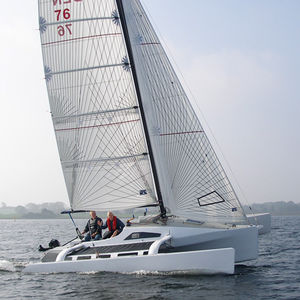
- Open sailboat
- Cruising sailboat
- Regatta sailboat
- Cruising-racing sailboat
- Trailerable sailboat
- 1-cabin sailboat
- Carbon mast sailboat
- Carbon sailboat
- Ocean cruising sailboat
- Wooden sailboat
- Coastal cruising sailboat
- Folding arms sailboat
- Foiling sailboat
Lydius-F82R
The building of the Ian Farrier designed F82R trimaran
Friday, June 22, 2012
- Rebuild of a F25 daggerboard

Tuesday, September 6, 2011
Mainsheet and gloves.

Monday, August 22, 2011
More update.

Wednesday, August 17, 2011
Summer update.
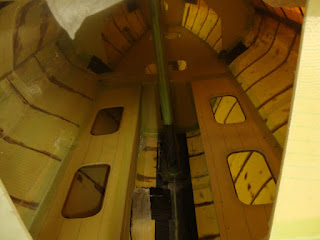
Monday, March 28, 2011
Taping ancher well floor and forward bulkhead.

What is a F82?
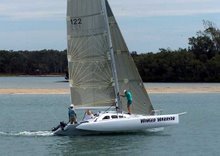
ON THE SLIP
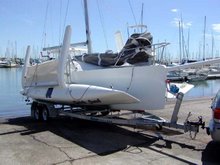
The former model F25C
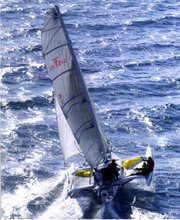
Blog Archive
- ► September (1)
- ► August (2)
- ► March (7)
- ► February (10)
- ► May (2)
- ► April (1)
- ► March (2)
- ► February (4)
- ► January (5)
- ► November (3)
- ► April (3)
- ► January (3)
- ► December (3)
- ► June (1)
- ► April (4)
- ► March (3)
- ► February (11)


Other F-Boat builders and other F links
- Nicos F85SR
- Andrew's F82
- Rod's F82 Australia
- Etienne & Annie's F82 (in french, use Google Crome to translate)
- Bukvaj F82 and other multies
- Farrier Marine, Inc.
- Grant's F22
- Optimum F22
- Tor's F 22R
- Tatiana F32
- Tom and Carols F32
- Nils Helbig F9R
- Allan Smiths F44SC
- Alcatraz F41
Popular Posts

- Infusion port side Hi all It's been a long time but this project is not over yet allthough some might have that thought..... I tried to infuse the outer ha...


Used FARRIER Boats for Sale
Buy and sell used farrier boats.
Find Used FARRIER boats for sale throughout Australia with yachthub.com - the best referenced boating website in Australia and New Zealand. Searching and finding your next Used FARRIER boat is easy on yachthub.com, with listings of Used FARRIER yachts for sale from the largest range of boat dealers and private advertisers.
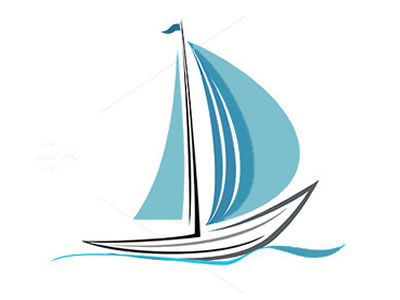

- My Searches
- Watch List (0)
- Sign In
FARRIER F-82R AFT CABIN

Used Yachts For Sale
Sailing tris to 30ft, farrier boats for sale, farrier f-82r boats for sale.

FARRIER F82R Trimaran - Unfinished project in BOORAL, Queensland for sale

OFFERS PLEASE Offers could include trade in of a suitable Trailer Sailer. Boat-builder

Unfinished project

FARRIER 680 TRAILERABLE TRIMARAN FLOATS

Haines Hunter Tramp Farrier Folding Trimaran Fibreglass

4.2 mtr fibreglass boat (unfinished project)

SAILING 8mt CAT UNFINISHED PROJECT / MUST SELL

Farrier International
a Division of Daedalus
The F-22 is a new design that has been developed in New Zealand by Farrier Marine (NZ) Ltd. The production F-22 is now available and is being built in the United States.

First Ever Sailing Review and Video of the F-22
2017 production f-22 specifications and options.
The F-22 was initially available in plan form for those who wished to build their own, but the production version is now readily available, so plans have been withdrawn from sale in order to concentrate on ramping up production.

Folding trimarans are more complex craft and difficult to build at low cost, particularly when combined with the desired low weight. Some trailerable multihulls are available for much less, but can often be no more than two or three very narrow fiberglass hulls, with little or no room, all tied together with a couple of basic aluminum or fiberglass beams.

Value is hard to find with many such boats, and the quality or configuration frequently does not justify the expense to buy, or the time required to build. In some cases it is surprising that they can cost so much when one gets so little. The F-22™ is intended to solve this problem, as a brand new entry level design, and intended to be a light weight, roomy, low cost trailerable trimaran, which is available as a full production sail-away boat.

The F-22 comes in two basic models, the full cabin cruising version as per current production version, with a standard rig, or taller racing rig.

Overall, the main design object was to achieve just the right balance between room, performance, and safety. Like all Farrier designs, the F-22 is a true and practical cruiser, but one that also happens to perform very well. The other main requirement was to keep both cost and building time low, and, to help achieve this, many aspects of the F-22 from design and building to marketing are being done quite differently.

General Background
The F-22 is intended to be a modernized version of the Farrier Trailertri 680/720, which pioneered the folding trimaran concept back in the seventies and eighties. Hundreds of such Trailertris were built from scratch, by many who had never built a boat before, and these first generation Farrier designs proved that the trailerable trimaran had a great future.

The production F-27 then followed, this being the first ‘second generation’ design and represented a major leap forward in hull shapes with its low rocker, and planing center hull, while retaining the same basic well proven beam structure and folding system. Construction also advanced significantly with round bilge hulls and foam core becoming standard. It was also one of the first production boats in America to use extensive aerospace vacuum bagging techniques for most parts, along with significant use of carbon fiber.
The F-22 features an even more integrated and further improved third generation beam and folding system, as developed for the F-32 and F-33. It retains the current and well proven hull lines, with evolutionary improvements, coupled with many detail upgrades.
Design Overview
The F-22 has been designed as a very versatile boat. It has more usable room the F-24 due to the many design refinements, and being a light and very simple boat, it is also towable by a 4 cylinder car, a very important factor with high fuel prices.
Hulls: Main hull lines have been optimized further with a higher displacement being achieved, but with a lower wetted surface area, while it has a slightly flatter bottom with less rocker so it will plane earlier. More interior room has also been created by optimizing main hull ‘underwing’ shape to exactly match the folded float sides.
Floats : These are significantly larger , with much more buoyancy lower down and further forward, for the maximum performance, and a lower heel angle.
The extra buoyancy in the bows is very important for today’s taller rigs, as just adding a larger rig onto an older hull design can generate bad habits and control problems. In comparison to the older F-24, besides having greater buoyancy overall, the F-22 floats have 43% more buoyancy in the first 200mm (8″) of float bow immersion for significantly greater fore and aft stability.

Floats are also flangeless as with the F-32 and F-33, for a cleaner, smoother look, along with less drag. Flangeless floats have significant structural advantages with the join seam being loaded under compression, rather than shear or peel, which means that water pressure will actually supplement the join seam glue, holding it together, rather than trying to break it apart as is shown by the following comparison:

More Details On Float Options
Deck: The cockpit is very long and a little wider than earlier designs, for a more spacious feel. The usual cockpit mid-bridge is to be eliminated by some careful engineering, and replaced by a removable compression strut for when needed (such as racing). This will leave the aft mounted traveler as the only obstacle across the cockpit, but one that is well out of the way.

The cabin roof camber and edge rounding have both been reduced to make cabin top more user friendly, safer to walk on, and easier to build. For lower weight and cost, only one winch will be required on most models, and this will be able to control all sheets and halyards.
Beams: The new F-33 style third generation beams and folding system are probably the biggest difference over earlier designs, with slimmer, more curved beams, that are set significantly higher. Beam tops are wide and relatively flat, for convenient and safe walking areas, while the wide overlapping flanges deflect any spray down, and cover lashing gap along wingnet edges, eliminating any chance of feet going through this area.

Folding struts are anchored directly to the beams (no metal brackets), but using an even simpler system to keep costs low. The shorter beams are mounted externally to the cabin, for more interior room, and give a significantly lower trailering height with less windage when towing (less fuel required).

Compared to the F-24/C24/Sprint750, still the best benchmark for this size boat, the F-22 beams have 18% less frontal area, are higher off the water (see drawing further below), and are significantly lighter at only 10kg or 22lb s each. This, coupled with the F-22’s larger floats, all add up to a faster, and much drier boat.
Rig: This is very simple, with rotating mast, all synthetic shrouds – turnbuckles and all metal parts have been eliminated wherever possible.
Sails: Three sails are standard, for simplicity and ease of use, these being main, jib, and a larger screacher. Mainsail is boomless, to save both weight and cost (and sore heads), while the longer luff of the boomless main is more efficient, and gives a lower center of effort. A roller furling boom is also optional if desired. Jib tack and/or furler (if used) is mounted partly below foredeck, for a deck sweeping jib for maximum efficiency, while also keeping sail area low down where it should be. Screacher mounts to the end of the aluminum bow pole, which can be pivoted up when needed.

The standard F-22 performance level is quite high due to the light weight, but not scaringly so due to the efficient low profile rig. This rig is designed to be very suitable for the average cruiser, and not over powering as can be the case with some more extreme designs. However, for experienced sailors who like to sail more on the edge, the F-22R with its taller racing rig is optional, and this is even faster than the F-24, and competitive with the much longer F-82 (26′ 10″).
The F-22 has more beam and more buoyancy further forward than any other Farrier design, and while this makes the F-22 very safe, it should be noted that the 35.1′ (10.7m) F-22R mast is very tall, and with a very powerful sail plan, so the F-22R is not a good choice for cruisers in heavy wind areas.

Foils: Daggerboard or centerboard options are available. The daggerboard is the simplest and most efficient and its case helps to support the mast. The centerboard can be more convenient, its offset case taking up less room in the cabin, plus it will kick back should it hit bottom. Tapered foils are being used, as these can be longer with less wetted surface area – or more efficient. Daggerboards are never used in the floats as these have major drawbacks, including being twice as complex, and heavier. They also do not save any interior space compared to an offset centerboard, which is much more practical and simpler.
Directional control is via the latest transom mounted retractable daggerboard rudder system, for maximum efficiency and simplicity.

Auxiliary : An outboard of 4 to 8 HP is recommended, and this is mounted on an offset pivoting bracket, forward of the stern, to minimize cavitation.
The basic interior layout is very similar to the F-24, with a double forward and two single berths on each side, which will also extend down the cockpit sides as quarter berths.

CRUISING CABIN VERSION
Galley expands out into cabin for when used, and can folded away when not in use, for more cabin room (full details in Specifications). Head can be located as shown and a full width screen across cabin center can give basic privacy when needed. An additional aft berth is also be possible under the cockpit for those who don’t mind limited headroom (plenty of width). A future aft cabin option will however make the aft berth very comfortable.

Cabin sides have been moved outboard to be more parallel to centerline than earlier designs, which creates more interior storage room. The early Trailertri designs had wing berths, which work well, except there was no storage underneath. Thus, when one loaded up the boat, gear tended to be thrown on the wing berths, and this then ended up on the floor or settees when sleeping, creating a very messy boat. To overcome this on later designs, the wing berth areas were turned into dedicated storage areas while the settees were used for berths, and this has worked out far better.

There is standing headroom under the large pop-top. This can also slide forward for quick cabin access, have the aft end only lifted to act as a dodger, or lift completely up to considerably increase comfort and room below. Sides can then be fully enclosed/screened.

The new externally mounted beams increase the interior room significantly, and a good example of this can be seen with the forward beam bulkhead opening. This is now a min. 6″ (150mm) wider than earlier models (at 4′ 4″ or 1.32m), giving a very spacious feeling to the cabin, and making the forward double berth area noticeably roomier.

Folding and Trailerability
The F-22 uses the well proven Farrier Folding System™, easily the most popular folding system world wide, and now further improved with the new ‘third generation’ beams and folding system. Besides making building easier, the new configuration uses shorter beams and eliminates the ‘nuisance’ beam recesses in the main hull deck of earlier designs, improving safety, while giving a much cleaner look.
Early designs, including the F-27, always had longer beams than necessary, with more hold down beam bolts than required structurally, in order to provide a ‘fail safe’ folding system. The beams actually ended near the center line, and took up as much interior room as telescopic beams. Double or even triple beam bolts were also used which made the beams strong enough on their own, even if the primary structural member (the lower folding strut) failed. This ‘fail safe’ factor was very important to help reassure early buyers that this totally new type of craft would be strong enough, but this is no longer a factor.

The Farrier Folding System has now proved itself beyond doubt, and there has never been a single failure of any lower folding strut, in over 30 years. Thus it was possible to begin eliminating beam bolts and shorten the beams, as with later designs such as the F-24 and F-31. The F-22 goes even further, with beam length set at the minimal optimum, with no interior intrusion at all. The resulting short beams, braced by the lower folding struts, are the most efficient beams available for a trailerable trimaran.

The F-22 third generation beams are shown above. These are much cleaner, with a lower trailering height, plus they eliminate the nuisance recesses into the cabin as shown below (F-24/Sprint 750). This gives the F-22 more room inside, plus any need for awkward covers as are sometimes used is eliminated. Such covers also tend to get in the way when folded, and are easily broken.

The old style beams also have the join flanges along the lower edge, and any spray from wave tops hitting the beam fronts is deflected upwards. The F-22 join flanges are instead on the top, where they can trap any such spray, and deflect it downwards, away from the crew, giving a much drier boat.
The wider deck of the F-22 can also be seen, with less rounded corners, which gives a safer walking area forward beside the mast, as well as more room inside. The rounded corners seemed a good idea for the F-24 at the time in 1991, but proved to be a mistake, as walking along the deck became more difficult and riskier, particularly when on the trailer. The F-27 was always right on the mark here, with its flatter roof with smaller radius corners, and thus it was decided to use this again for the F-22. Similarly, the F-22 beam tops are flatter making them significantly more comfortable to both sit and walk on.
The F-22 beams and folding struts have also been lifted higher than earlier designs, with lower folding struts now being anchored inside the beams. The struts are thus even higher, and this will help eliminate any nuisance spray that can come from folding struts on occasion at high speeds. The differences are shown by the following comparison drawing of the F-22 and the F-24 design (blue lines).

F-22 to F-24 Comparison
The significant improvement with the F-22 can be clearly seen, along with the F-22’s wider overall beam, and larger floats.

More information on the many advantages of the Farrier Folding System can also be seen at:
Farrier Folding System Advantages

For ease of use, everything is being designed so that rigging and launching can be done single-handed. The target setup time from arriving at ramp and having boat rigged, and in the water, is 25 – 30 minutes.

Production F-22 Availability
The F-22 was initially available only in plan form, but is now only available as a full production sail away boat. This will come as a ‘boat in a box’, that can be shipped anywhere around the world and can be assembled by anyone, or by a local boat builder for those without the time or inclination to do it themselves.

The production F-22 will be marketed differently from earlier designs, with enthusiastic owners being sought, who are willing to buy their own boat, and then use it for demonstration sails, and/or local promotions, in return for a commission on sales. This could become a very enjoyable part time business for those interested, and may be eventually be setup as full time F-22 franchise opportunities.

An Important Note On Performance
Like all Farrier designs, the F-22 is intended to be a comfortable, safe cruiser, and one that can also be fast, but the performance is achieved by efficiency, not excessive power. However, many competitors over the years have put a great emphasis on performance and race results, with very tall rigs and minimal room. It would be easy to make the F-22 faster than the F-31 for instance – just eliminate most of the room, and put on a big rig. But what is usually not mentioned with such boats is the greater danger of capsize or pitch pole, with wind capsize speeds that can be lower than 25 knots.
Such boats have very little practicality, are scary to sail, their crews soon get tired of the lack of comfort, lack of room, and the need to rent a nearby motel when participating in race events away from home. They also get tired of the hours trying to assemble them, or the hassles in retracting the floats.
Others have found that if they really want to go fast with no comfort, a cat with a couple of slender 30′ (10m) hulls with a tall mast is better value (eliminate the center hull altogether), and such a cat may be able to at least sleep two in each hull instead of just two in one. However, while such boats can be cheap, they are not good all round performers, and remain very impractical for cruising or safe family sailing. One currently available appears to have a wind capsize force of less than 15 knots, and capsized during a recent race in only 14 knots. Not a good feature and any multihull that needs such a big rig to compete is not a very safe or efficient boat.

All Farrier designs (except racing versions) use a minimum wind capsize speed of 30 knots or more, to ensure safety for crew and families, plus provide both room and performance. Even racing ‘R’ versions seldom use a wind capsize speed of below 25 knots. A few good race results are just not worth the extra risk and discomfort.


IMAGES
VIDEO
COMMENTS
David Wilson's F-82R in Australia. The F-82 superseded the original F-25A trailerable yacht for home builders, and comes in two versions: F-82A a lower powered version for cruisers and can be built with either wood or foam strip planking. F-82R - a higher powered version for racers, and the direct equivalent to the F-25C - one of the fastest multihulls of its size in the world.
Sailing 'Numancia' a Farrier F82R from Manly to Moreton Island in S/E 20-30kt forecast. Huge battened jib and main set to 2nd reef - max speed 17ktsMusic - P...
Equally great as a racer around the bouys or easily towed to the Great Barrier Reef to enjoy family cruising. Price. AU $75,000 Reduced. Vessel Name. Freelance. Launch Year. 1900 approximate. Length. 26' 11" - 8.20m.
But his first trimaran (F82R) came only in 2015 and Andr é also named it Flaneur in memory of those early days. Since owning it, Andr é has annually made a raft of improvements to get it to perform at progressively higher levels, building new carbon composite amas, plus solid CF C-foils for added stability plus a new rudder and daggerboard ...
An idyllic sail doing a rum race on Lake Rotoiti NZ on Sledge, an Farrier F82R trimaran
Trimarans. trimaran F-22 . cruising-racing 1-cabin carbon. trimaran F-22R. racing folding arms. trimaran F-22F. racing 1-cabin carbon. trimaran F-33. cruising-racing 1-cabin carbon mast. trimaran F-33X . ocean cruising 1-cabin carbon mast. trimaran F-85SR. racing foiling. trimaran F-82A. coastal cruising wooden trailerable.
Ian Farrier designed homebuilt 27ft folding trimaran F82R model. were sailing after a race in Sarasots Bay with friends.
Model: Used Farrier F-82r, Hull:Composite, Category: Sail Boats | Boats Online Sailing Trimaran, State: New South Wales (NSW), Description: One of Farrier's great designs. Equally great as a racer around the bouys or easily towed to the Great Barrier Reef to enjoy
An icon of the multihull world. It is said that there are more 2000 Farrier designs (mostly trimarans) sailing around the world. Begining in the 1970's with TRAILERTRI series in Australia, Farrier sold detailed plans (as well as kits) for the amature builder. Most of these boats, (and most Farrier designs to follow) incorporated his ingenious system for folding the floats close the main hull ...
If you are in the market for a trimaran, look no further than this 2007 Custom Built Farrier Marine F82R, just reduced to $39,900 (offers encouraged). This sailboat is located in Boise, Idaho and is in decent condition. She is also equipped with a Honda engine that has 300 hours. We are looking for people all over the country who share our love ...
Reviewed: Farrier F-22 Trimaran. You could be forgiven for not realizing the F-22 trimaran is, in fact, a first-rate pocket cruiser. The boat's narrow, plumb-bow entry, powerful amas, sleekly sculpted cabintrunk, expansive cockpit and powerful high-aspect rig all seem to speak to pure performance. A single glance belowdecks, though, is all it ...
Summary. 27 ft. folding trimaran. Rear cockpit design. 37 ft. aluminum rotating wing mast. Roller furling boom w/ interior outhaul. Trailer included! Here's a 27-foot folding trimaran custom built by the owner. The Farrier brand was started by Ian Farrier back in the late '60s and was a home built kit from plans by the designer, Ian Farrier.
The Farrier Folding System™ means less intrusion into cabin and no open 'foot traps' in the deck.. One key to the success of Farrier trimarans is the easy trailerability made possible by the unique Farrier Folding System™.. The Farrier system is the most structurally sound trimaran folding system available, with no hinges in the beams or the critical beam to float join, while corrosion ...
Farrier F-82R. This listing is no longer available. You can however view similar listings using one of the four links below.
Trip to Puerto Galera, Philippines, on the farrier trimaran
The F-22 is available as three different models as follows: F-22 - the standard model with limited options, and ready to go sailing once sails and safety gear are added. This is the high volume production version, and to be built in a lower cost area for the best value.
AU $75,000. The Farrier Command 10 trimaran is a sleek and versatile sailing vessel designed by Ian Farrier. With its innovative folding system, it allows for easy trailering and berthing. The trimaran features a spacious cockpit, efficient sail plan, and advanced hull design for speed and stability. Its ten-meter length provides a good balance ...
Lydius-F82R The building of the Ian Farrier designed F82R trimaran. Friday, June 22, 2012. Rebuild of a F25 daggerboard. For my fellow trimaran owner/builder Per Folm Hansen I made an attempt to rebuild an older daggerboard to a High aspect shape that is Larry Wood that gave me the idea.
Find Used FARRIER boats for sale throughout Australia with yachthub.com - the best referenced boating website in Australia and New Zealand. Searching and finding your next Used FARRIER boat is easy on yachthub.com, with listings of Used FARRIER yachts for sale from the largest range of boat dealers and private advertisers. Hide Sold Listings.
Farrier F-82r Aft Cabin: Sailing Trimaran for Sale | Carbon Fibre Epoxy/ Glass/ Foam Composite With Carbon Fibre Reinforcement Per Spec. Sail Boats | Boats Online
FARRIER F82R Trimaran - Unfinished project in BOORAL, Queensland for sale . Price: R 35,000 Share: Share on Facebook Share on Twitter Print this ad Edit your ad Report abuse. Category: Boats, Yachts and Parts Address: BOORAL ...
The F-22™ is intended to solve this problem, as a brand new entry level design, and intended to be a light weight, roomy, low cost trailerable trimaran, which is available as a full production sail-away boat. Neil Wilkinson's plan/kit built F-22R (with cuddy cabin) at Team New Zealand's dock in Auckland. (Neil was the foil engineer with ...
Trimaran boats for sale on YachtWorld are listed for an assortment of prices from $24,900 on the more modest side, with costs up to $4,538,507 for the most extravagant model yachts. What Trimaran model is the best? Some of the most iconic Trimaran models currently listed include: Orma 60, DC 76, Hanstaiger X1 and SeaRail 19. Specialized yacht ...